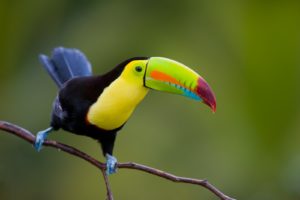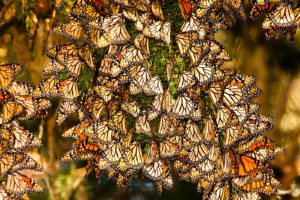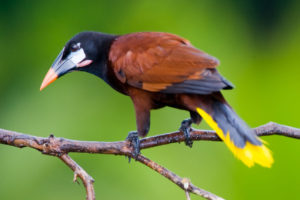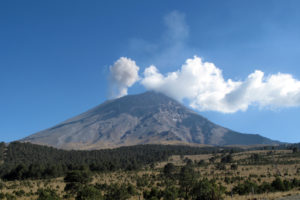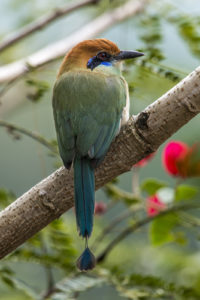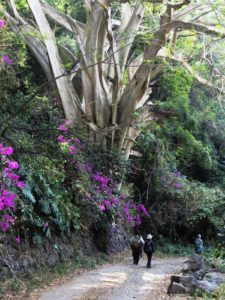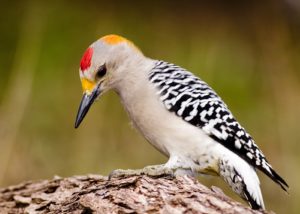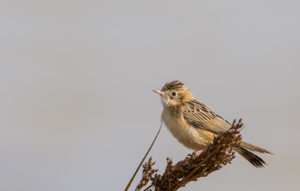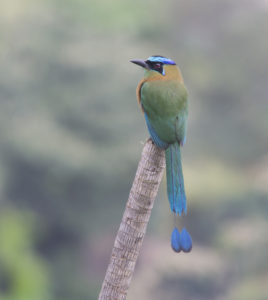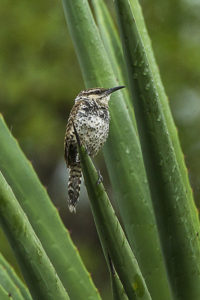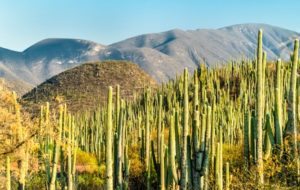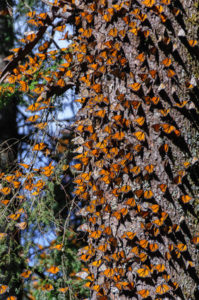Monarchs and Birds of Mexico
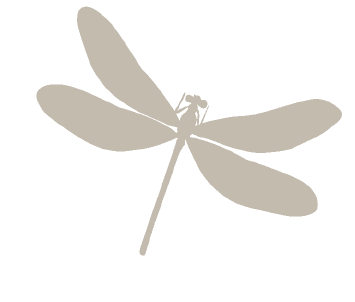
February 5 to February 13, 2021
$3,250 | ($500 deposit due upon registration)
11 participants max
Somersaulting oropendolas and iridescent motmots frolic between rows of abandoned coffee plants. Toucans snack on tropical fruits above you on a mountainous, tropical hike to find the continent's rarest wren. The next morning's sunrise illuminates the top of a strange cactus forest hosting birds found nowhere else. And each day's adventure brings you closer and closer to the breathtaking finale: the overwintering grove of nearly every Monarch butterfly in North America's eastern seaboard.
Additional Information
Pacing and Expectations: The daily travel schedule on our Central Mexico birding tour varies to account for weather, bird species and habitat. We will often want to be out birding very early in the morning—we may have dawn breakfasts or take a box breakfast into the field.
The tour involves generally easy walking, though some hill climbing of over an hour is necessary to reach the Monarch butterflies and the site for Sumichrast’s Wren. Participants should be able to walk the equivalent of going up a steep hill for a mile or so. A good way to determine if you are fit for the trip is if you can walk up and down stairs for an hour. We will frequently be higher than a mile in elevation, at times up to about 10,000 feet, and sometimes on rocky or muddy trails.
That said, the pace will be slow - we’re birding, after all! There will be a couple of long drives of up to four hours, but we will be stopping at one or two places along the way to break up these journeys into shorter segments.
Around noontime we stop to have a sit-down meal at a restaurant. If it is hot outside, as it can be in most of Mexico, we may rest for an hour or so during the middle of the afternoon.
We will be visiting in the dry season and rain is unlikely. During the three days of the trip when we are at higher elevations, we will encounter cool weather, possibly close the freezing temperature for the first hour or so in the morning. During dinner we usually discuss the day’s activities and review the list of birds seen and heard.
Accommodations during the tour vary from charming colonial hotels to hotels with beautiful gardens in the countryside. First and last night hotel is in Mexico City by the airport. Specific hotels will vary depending on availability.
Clothing: Pack light field clothing of neutral colors. Bring several pairs of long pants and comfortable, light, airy shirts. Long-sleeved (relaxed fit) shirts are useful for protection from the sun, as is a light hat or cap. Though rain is unlikely, do pack a rain jacket or small umbrella. Be sure to have a pair of comfortable walking shoes or hiking boots, plus a second pair of tennis shoes or sandals. A fleece jacket, hat, and gloves is important for our time in the highlands, as weather may approach freezing temperature early in the morning. You may want more casual clothing for traveling or dinners. A small washcloth and handkerchiefs will be helpful.
Equipment: Bring a pair of binoculars, a field guide and a camera with extra batteries. The guides will carry spotting scopes. Pack sunglasses and sunscreen, a small flashlight or headlamp, a small alarm clock (a smartphone will work), insect repellent, a small daypack, and hiking poles (optional).
Health Considerations: Please consult your physician before the trip for any concerns relating to travel and exertion at high altitudes. Also check with your doctor about any recommended immunizations. As for foods, all meals at the different lodges are perfectly safe to eat, and we will have easy access to potable water throughout the journey.
Participants should be able to hike on moderate, uneven, and sometimes steep terrain, up to 4 miles per day. Most days will have very little, if any, strenuous walking. However, the monarch reserves are located at high altitudes and require a steep hike at a high altitude.
Adam Kent
An Anhinga sparked Adam’s passion for birds when he was about five years old. Since then, a love of sharing his enthusiasm about the natural world has led Adam to work on many different environmental and education projects, including as a naturalist guide. He has guided trips from Alaska to Tierra del Fuego and many points between. His varied biologist positions have included training naturalist guides in Baja California, assessing sites for the Great Florida Birding Trail, and working as Florida’s first Scrub-Jay Conservation Coordinator. He is currently President of the Florida Ornithological Society and is very involved with the state’s second breeding bird atlas. One of Adam’s birding highlights was making recordings that led to the description of a new species of bird in Mexico, the Nava’s Wren. Adam and his wife Gina reside in Gainesville, Florida where they can be found relaxing on their front porch while eBirding the woods along a local creek.
Sean Beckett
NBNC's staff naturalist, Sean Beckett, has guided wildlife safaris and birding trips across North America for the last decade. In addition to his extensive guiding experience, his background includes several avian research positions ranging from Atlantic Puffin monitoring in coastal Maine to Ferruginous Pygmy-owl sampling in northern Mexico. Sean coordinates North Branch Nature Center's Monarch Watch butterfly tagging program, and looks forward to searching amid millions of overwintering monarchs for the wing tags applied by youth here at NBNC. Sean holds a M.S. from the University of Vermont's Field Naturalist program.
The trip cost includes:
- Pre-departure orientation gathering at NBNC
- Expert NBNC guide
- In-country expert bird guide
- Airport hotel transfers
- All accommodations
- Entrance fees to parks
- All transportation in a private bus
- Water
- All meals during the trip
The trip cost does not include:
- Airfare to and from Mexico City
- Cancellation insurance
- Alcoholic beverages
- Extra hotel services
- Snacks
- Guide gratuities
Ready to go to Mexico?
Email [email protected] to get signed up.
Itinerary
Day 1 - Arrival and Orientation
Our Central Mexico birding tour begins in Mexico City. Our tour leader will meet you in the hotel lobby at 7:00 pm for dinner and to become acquainted, discuss the tour, and answer any questions. For logistical ease, our first hotel is either at the airport terminal or a short shuttle drive away. Overnight in Mexico City.
Day 2 – Mexico City to Amatlán
This morning we make one or two birding stops to look for the first of our Mexican endemics, possibly Dusky Hummingbird or Black-backed Oriole. After lunch, the drive to Amatlán puts us in a blend of tropical semi-evergreen forest and abandoned coffee plantation. The bird life here is completely different from what we encounter elsewhere on this tour and the area is very rich in species including such tropical gems as Blue-crowned/Lesson's Motmot and both Chestnut-headed and Montezuma’s Oropendolas. We spend this afternoon and the next morning in this area, keeping in mind that this is a special area for three birds that are rare elsewhere: Wedge-tailed Saberwing, Sumichrast’s Wren and Fan-tailed Warbler. This is also one of the few forests in Mexico where it is possible to see 3 species of toucans. Night in Fortin de las Flores.
Day 3 - Amatlán to Tehuacán
After spending a productive morning birding around Amatlán, we drive to Tehuacán, stopping en route on a little side road to look for mid-elevation birds. Tehuacán is a 17th-century town, but archaeological evidence indicates that it is in fact one of the earliest places where agriculture was practiced in the New World over 8000 years ago. Night in Tehuacán.
Day 4 - Tehuacán to Cuernavaca
This morning we visit an impressive and unique ecosystem, a dense forest of giant columnar cacti (one usually doesn’t think of cacti as forming forests!). When the early morning sun’s rays hit the tops of the cacti we can expect to see Bridled Sparrow, Gray-breasted Woodpecker and Boucard's Wren perching on the tall plants. Afternoon birding near Cuernava will depend on timing. Night in Cuernavaca.
Day 5 - Cuernavaca
Cuernavaca is in the transition zone between tropical and temperate regions, and short drives take us into a variety of different types of forests in both. First, we visit a trail through tropical dry forest a few kilometers east of Cuernavaca. This trail always produces a large number of bird species endemic to the lowlands of western Mexico. In this season the forest will be dry, most trees leafless and the birds should be easy to see. More than 20 Mexican endemic birds occur here, and although it is difficult to predict which ones we will see, there is a very good chance of finding Golden-crowned Emerald, Violet-crowned and Dusky Hummingbirds, Golden-cheeked Woodpecker, Thick-billed Kingbird, Rusty-crowned Ground-Sparrow and Black-chested Sparrow, among others. We will also be able to practice identification of Myiarchus flycatchers, because four particularly similar-looking species are rather common in this forest. In the afternoon, we make a stop or two in search of birds of highland forest including, possibly, Amethyst-throated or Bumblebee hummingbirds. Night at Cuernavaca.
Day 6 - Cuernavaca to Zitacuaro
This morning we visit a mountain meadow, a stronghold for the extremely local and endangered Sierra Madre Sparrow. Another Mexican endemic sparrow is common here too, the Striped Sparrow. Nearby, we visit a temperate forest which often produces a large number of Mexican endemic and specialty birds, including Russet Nightingale-Thrush, Green-striped Brush-Finch, Elegant Euphonia, Strickland’s Woodpecker and many others. In the afternoon, we make a relatively long drive to to Zitácuaro, a town close to the Monarch Butterfly wintering grounds in Michoacán. We stop en route to look for one of the most localized birds of the trip in the Lerma marshes west of Mexico City, one of the last homes of the threatened Black-polled Yellowthroat. Other stops are in pine and fir forest, where possibilities include Pine Flycatcher, Golden-browed Warbler, Red Warbler and Colima Warbler. Night in Zitácuaro or Jungapeo.
Day 7 - Dry Forest and Monarch Butterflies
In the morning we visit a tropical dry forest near Zitácuaro where Happy Wren, Golden-cheeked Woodpecker, Blue Mockingbird and many other birds may be found. In mid-morning, we drive to a site where millions of Monarch butterflies spend the winter, having lunch on the way. The late morning is the best time to enjoy the butterflies. We will not be alone here, because this is a very popular destination for Mexicans and foreigners alike. Around 15 to 20 million Monarchs, most of the population of the United States and Canada spend the winter here after travelling up to 120 kilometers per day in their October southward migration. During the early winter they spend most of their time dormant, with their wings closed, in dense clusters covering the fir trunks and branches. This is a spectacle in itself but the Monarchs are even more impressive in February when they spend most of the day sunning themselves with their wings open, occasionally fluttering around to feed on nectar. Night in Zitácuaro or Jungapeo.
Day 8 – More Monarchs and return to Mexico City
We spend this morning visiting a second site, Sierra Chincua, for wintering monarchs, which typically hosts hundreds of thousands of monarchs, and significantly fewer tourists. As we take in the magical setting, we'll discuss monarch ecology and learn about the multigenerational migrations of these impressive insects. After our second butterfly experience and lunch, we spend the afternoon birding a road through pine-oak forest near Zitácuaro, where the many birds we may see include the cute Tufted Flycatcher, White-throated Thrush and Chestnut-sided Shrike-Vireo. Night at Mexico City, at a hotel adjacent to the airport.
Day 9 - Departure
Our Central Mexico birding tour ends today. After breakfast at the hotel, we'll catch a flight back to the United States and dream about monarchs and rare Mexican birds for the whole flight home.

713 Elm Street
Montpelier, Vermont 05602
(802) 229-6206
Hours: Center Open Monday-Friday 9-4
Trails Open 24/7

